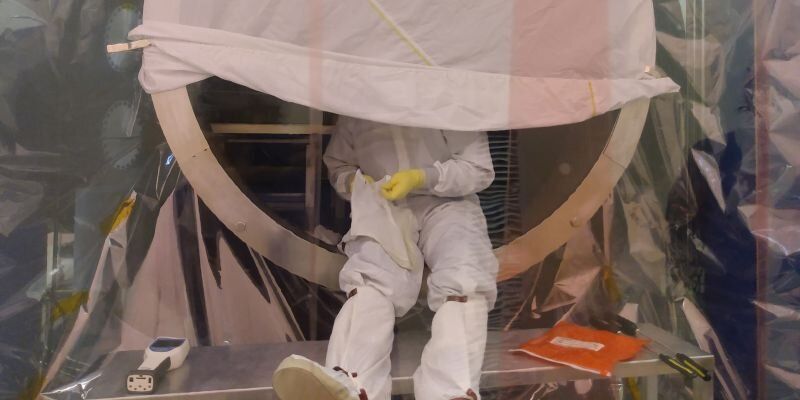FILE PHOTO: Silhouettes of laptop users are seen next to a screen projection of binary code are seen in this picture illustration taken March 28, 2018. REUTERS/Dado Ruvic/Illustration Reuters.



Researchers from Sorbonne University in Paris have achieved a highly efficient transfer of quantum entanglement into and out of two quantum memory devices. This achievement brings a key ingredient for the scalability of a future quantum internet.
A quantum internet that connects multiple locations is a key step in quantum technology roadmaps worldwide. In this context, the European Quantum Flagship Programme launched the Quantum Internet Alliance in 2018. This consortium coordinated by Stephanie Wehner (QuTech-Delft) consists of 12 leading research groups at universities from eight European countries, in close cooperation with over 20 companies and institutes. They combined their resources and areas of expertise to develop a blueprint for a future quantum internet and the required technologies.
A quantum internet uses an intriguing quantum phenomenon to connect different nodes in a network together. In a normal network connection, nodes exchange information by sending electrons or photons back and forth, making them vulnerable to eavesdropping. In a quantum network, the nodes are connected by entanglement, Einstein’s famous “spooky action at a distance.” These non-classical correlations at large distances would allow not only secure communications beyond direct transmission but also distributed quantum computing or enhanced sensing.


Hundreds of American hospitals are being targeted in cyberattacks by the same Russian hackers who American officials and researchers fear could sow mayhem around next week’s election.
The attacks on American hospitals, clinics and medical complexes are intended to take those facilities offline and hold their data hostage in exchange for multimillion-dollar ransom payments, just as coronavirus cases spike across the United States.
“We expect panic,” one hacker involved in the attacks said in Russian during a private exchange on Monday that was captured by Hold Security, a security company that tracks online criminals.

Plastic waste comes back in black as pristine graphene, thanks to ACDC.
That’s what Rice University scientists call the process they employed to make efficient use of waste plastic that would otherwise add to the planet’s environmental woes. In this instance, the lab of Rice chemist James Tour modified its method to make flash graphene to enhance it for recycling plastic into graphene.
The lab’s study appears in the American Chemical Society journal ACS Nano.

Senior U.S. officials revealed Thursday that security threats have been made against top Pentagon authorities not only when traveling outside the U.S., but when on American soil.
Frist reported by NBC News on Thursday and verified for Fox News by a senior Department of Defense representative, security officials believe the threats made could be linked to the killing of Iranian Gen. Qasem Soleimani by American forces in January, though definitive links could not reportedly be made.
The names of the Pentagon officials were not released, but they are believed to have been senior leadership involved in the operation that oversaw the takedown of Soleimani. Military leaders have also reportedly been targeted.

The United States has sold crude oil seized from four Iranian tankers earlier this year for some $40 million the AFP reports, citing a U.S. government official.
“We estimate that in excess of $40 million will be recouped by the United States related to the sale of petroleum from those four vessels,” Michael Sherwin, acting U.S. attorney for the District of Columbia said. Sherwin added that “a great portion” of the money will be donated to a fund for the victims of “state-sponsored terrorism”.
In the middle of August, the U.S. Administration said it had seized the fuel cargo of several vessels, alleging that the fuel came from Iran and was going to Venezuela. The confiscation followed a lawsuit filed by U.S. prosecutors to seize the cargo carried by the four vessels for violating U.S. sanctions against Venezuela.

Malchemy
The resulting diamond is identical to one pulled out of the ground — and Vince says Ecotricity is already capable of making about 200 carats every month.
“Making diamonds from nothing more than the sky, from the air we breathe — is a magical, evocative idea — it’s modern alchemy,” Vince told The Guardian. “We don’t need to mine the earth to have diamonds, we can mine the sky.”

Unless you’re a physicist or an engineer, there really isn’t much reason for you to know about partial differential equations. I know. After years of poring over them in undergrad while studying mechanical engineering, I’ve never used them since in the real world.
But partial differential equations, or PDEs, are also kind of magical. They’re a category of math equations that are really good at describing change over space and time, and thus very handy for describing the physical phenomena in our universe. They can be used to model everything from planetary orbits to plate tectonics to the air turbulence that disturbs a flight, which in turn allows us to do practical things like predict seismic activity and design safe planes.
The catch is PDEs are notoriously hard to solve. And here, the meaning of “solve” is perhaps best illustrated by an example. Say you are trying to simulate air turbulence to test a new plane design. There is a known PDE called Navier-Stokes that is used to describe the motion of any fluid. “Solving” Navier-Stokes allows you to take a snapshot of the air’s motion (a.k.a. wind conditions) at any point in time and model how it will continue to move, or how it was moving before.

Only a few years ago, scientists the world over celebrated as the first-ever gravitational waves were detected—confirming a long-held scientific theory and opening up an entirely new field of research.
Now, the international research team responsible for detecting gravitational waves has announced a further 39 gravitational wave events, bringing the total number of confirmed detections to 50.
The Laser Interferometer Gravitational-Wave Observatory (LIGO) and Virgo Collaborations, which include researchers from the University of Portsmouth, have today published a series of papers that record events including the mergers of binary black holes, binary neutron stars and, possibly, neutron star-black holes.